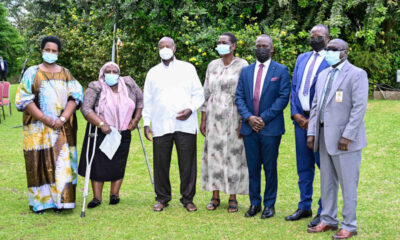human traffickingFeatures
The girl who said no to FGM
 While some arrests have been made and cases brought to Court in Uganda since the Female Genital Mutilation (FMG) Act 2010 was passed, implementation of the law remain a major challenge.
While some arrests have been made and cases brought to Court in Uganda since the Female Genital Mutilation (FMG) Act 2010 was passed, implementation of the law remain a major challenge.
The painful ritual that involves the cutting of a woman’s external part of her genitalia, remains pervasive practice in most parts of Sebei culture that encompass the districts of; Bukwo, Kween, Pokot and Kapchorwa. It has increasingly been performed in secret.
As different reports have clearly indicated, the practice of FGM is widespread, despite the passage of the bill. The Speaker of Parliament Rebecca Kadaga has noted as thus in some of her visits to the region.
Although some women and girls have managed to survive the unappealing practice, the prevalence rates are more than 90% in some sub-counties, especially those that are nearest to the Uganda’s border with Kenya.
Juliet Nakitende, is one of the few girls who managed to escape from the vice by a whisker.
Born April 4, 1988, in the Sebei Region , Nakitende got to know about FGM in 1998 after the death of her Cousin sister Sylvia Nalubowa who bled to death after the incident.
“…in 2000 my sister Claire Nalubega almost died after being cut, she couldn’t walk for months nor go to the toilet because of the exreme pain,” Nakitende told Human Rights Activist Aloysius Matovu Junior a few months ago.
From that ordeal that befell her family, Nakitende thought she would not be subjected to the practice. Alas, she was wrong .
“After witnessing all this I told my mother that I will not be cut hoping that they will spare me but it was not the case.
When I clocked 15 years old in 2003 , thy wanted to cut me but I managed to escape from home.”
After leaving her parents home, Nakitende found refugee in a neighbouring village called Pokot still in Kapchorwa District.
“I met an old woman whom I told about my distress. I thank God she welcomed and housed me for five months .”
However , Nakitende’s stay with the old woman was short-lived after her family started looking for her in every corner of the region and this forced her to run to Kampala, in a quest of saving her dear life.
When she came to the city, Nakitende told Matovu that she stayed with the old woman’s daughter a one Patricia Lumu who looked after her as her own daughter. Nevertheless, her family back home in the village was never tired of hunting for her so she and Lumu could move from place to place in hiding .
“A few months later, we started getting threats from my family that I should go back and brave the knife. This made us to move from one place to another so that we can hide away from them.”
In 2016,Nakitende got married to a one George Sserunkuuma who also hailed from Sebei . Sserunkuuma offered full protection to his wife since he was also against FGM. “We got threats from his family too on finding out that I was not cut.
According to Sebei customs mother in-law checks the daughter in law to confirm about the cutting because to them your not a full woman if your not mutilated,” Nakitende further narrated to the Human rights activists.
“In November 2018 , one night we got attacked by people who beat us badly saying we should die for disrespecting our culture. I cried for help and all I could remember is seeing the perpetrators running away .
This was the last time I heard from George my husband.”
The next morning, Nakitende woke up in hospital all bruised and wounded and this was the time she was informed about her 14 week pregnancy by then.” Fortunately the baby was never injured.
“She reported the case to police but they could not help because she didn’t have details of the attackers.
He further recalls that: “ Apparently, I do not know about her where abouts and the baby, but what am sure of she’s in hiding for her life.”
Harriet Gimbo , Head of Operations at Action AID Uganda recently told an online news website-Uganda Radio Network (URN) that FGM fight has become very hard due to a series of problems that have hindered many operations to end the vice .
According to Gimbo, FGM is still popular because it is forced into girls as an act of making them great strong women,wives by older persons in the communities.
She explains, some mothers push their children to go through the act as a away of bonding.
Among the Sabin culture,
Gimbo recommended the sensitization as an alternative way to fight FGM instead of a policy.
She says that girls need to know that there ways a girl can become a woman in the Sabin culture.”
Comments



















